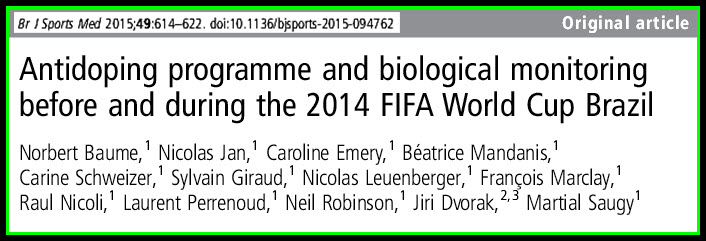Western blot research: A BlotCycler™ Application Note
Since 1966, the Fédération Internationale de Football Association (FIFA) has used WADA doping controls to ensure a fair competition prior and during the FIFA World Cup tournaments.
In 2014, FIFA implemented an important anti-doping program for the World Cup competition.
From March through June, before the 2014 World Cup finals, out-of-competition (OOC) anti-doping tests were organized to collect blood and urine samples from individual players from the 32 qualified countries. More than 750 OOC samples were collected.
This collection was the first step to implement the new strategy in football, the Athlete Biological Passport (ABP).
Then, during the 64 matches played in Brazil, another 300 blood and urine samples were collected In Competition (IC).
The purpose was to perform biological monitoring through analysis of blood and urine before and during the FIFA World Cup.
Methods:
All qualified players from the 32 teams participating in the World Cup were tested out-of-competition.
During the 2014 World Cup, 2–8 players per match were tested.
In total, over 1000 samples were collected and analyzed in the WADA accredited Laboratory of Lausanne, Switzerland.
BlotCycler™ automated Western Blot Device Application:
Among the many other tests that were performed on the blood and urine samples, ESAs were tested in serum samples subjected to affinity purification with EPO Purification Kit (MAIIA Diagnostics) using the Western blot.
Samples were passed to 10% in buffer (20 mM Tris pH 7.5, 0.1 MNaCl, 0.1% Tween 20 and 0.02% NaN3).
The diluted serums were passed through Millex GVfilters (0.22μm), purified by immunoaffinity and eluated with 50μL Desorption (low pH) buffer.
Then, pH-neutralisation was performed by addition of 5μL adjustment buffer (0.1 M Bis-Tris pH 7.0, 0.1 M NaCl,10 mM glycine, 0.1% Tween 20 and 0.02% NaN3).
SARCOSYL-PAGE Western blot technique was performed as previously described by Reichel, et al.with minor modifications.
BlotCycler™ technology was used for incubations (blocking and antibodies) and washing steps at 4°C.
Results:
The quality of the analyses was at the required level as described in the WADA technical documents.
The urinary steroid profiles of the players were stable and consistent with previously published papers on
football players.
During the competition, amphetamine was detected in a sample collected on a player who had a therapeutic use exemption for attention deficit hyperactivity disorder. The blood passport data showed no significant difference in hemoglobin values between out-of-competition and post-match samples.
Conclusions:
Logistical issues linked to biological samples collection, and the overseas shipment during the World Cup did not impair the quality of the analyses, especially when used as the biological passport of football players.
However,
Summary:
The two main lessons learned from the FIFA World Cup 2014 were:
First, that meticulous organization of anti-doping tests on the field and well-controlled shipments of samples to the laboratory by the anti-doping authority does not compromise the samples. This allows the accredited laboratory to provide valid results.
And second, no differences were observed between out-of-competition and post-competition hematological values.




